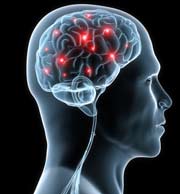
A research team, whose major investors include some of the biggest telecommunications companies in Japan, has announced that it has successfully deciphered the contents of human dreams with high precision by analyzing the human brain’s activity during sleep.
The group that conducted the research, International Telecommunications Generic Technology Research Center, has financial backing from two of Japan’s biggest telecommunications companies NTT and KDDI.
In order to achieve these results, the research group first placed the three men who participated in the experiment into a state of sleep. They were then woken up after several minutes and asked to recount the content of their dreams. During this time the researchers compared the brain activity patterns recorded during sleep with the men’s accounts. The experiment was conducted over 200 times.
Next, while awake, the participants were shown pictures from 20 different categories, including cars and animals, after which their brain activity was further analyzed. These results were then compared to the brain activity during sleep, where the researchers discovered that they could predict the contents from one part of a dream with an accuracy rate of over 70 percent.
While it is still not possible to decipher the brain activity responsible for the shape or color one sees inside of a dream, the research group remains optimistic that, with further research, this will also one day become a possibility.
Yukiyasu Kamitani who leads the research group commented:
“We’d like to use the method discovered this time around to develop technology whereby one can operate a computer through thought alone.”
Source: NHK News
Header image: ucdmc.ucdavis.edu
 Research from Tohoku University claims video games impair brain development in children
Research from Tohoku University claims video games impair brain development in children Effect of Dragon Ball-style Gravity Chamber on training studied at Chubu University
Effect of Dragon Ball-style Gravity Chamber on training studied at Chubu University Is there a correlation between sex and World Cup success?
Is there a correlation between sex and World Cup success? Nintendo answers questions on VR, 5G and staying behind the trends: “Our priority is entertainment”
Nintendo answers questions on VR, 5G and staying behind the trends: “Our priority is entertainment” New Japanese VR dating simulator reads your brainwaves and chooses the ideal girlfriend for you
New Japanese VR dating simulator reads your brainwaves and chooses the ideal girlfriend for you Foreigner’s request for help in Tokyo makes us sad for the state of society
Foreigner’s request for help in Tokyo makes us sad for the state of society Red light district sushi restaurant in Tokyo shows us just how wrong we were about it
Red light district sushi restaurant in Tokyo shows us just how wrong we were about it Anime girl English teacher Ellen-sensei becomes VTuber/VVTUber and NFT
Anime girl English teacher Ellen-sensei becomes VTuber/VVTUber and NFT McDonald’s new Happy Meals offer up cute and practical Sanrio lifestyle goods
McDonald’s new Happy Meals offer up cute and practical Sanrio lifestyle goods Japan’s massive matcha parfait weighs 6 kilos, contains hidden surprises for anyone who eats it
Japan’s massive matcha parfait weighs 6 kilos, contains hidden surprises for anyone who eats it French Fries Bread in Tokyo’s Shibuya becomes a hit on social media
French Fries Bread in Tokyo’s Shibuya becomes a hit on social media Historical figures get manga makeovers from artists of Spy x Family, My Hero Academia and more
Historical figures get manga makeovers from artists of Spy x Family, My Hero Academia and more Is Japan’s massive Shizuoka steak sandwich really as delicious as it looks in promo photos?
Is Japan’s massive Shizuoka steak sandwich really as delicious as it looks in promo photos? Tokyo Tsukiji fish market site to be redeveloped with 50,000-seat stadium, hotel, shopping center
Tokyo Tsukiji fish market site to be redeveloped with 50,000-seat stadium, hotel, shopping center Japanese ramen restaurants under pressure from new yen banknotes
Japanese ramen restaurants under pressure from new yen banknotes All-you-can-drink Starbucks and amazing views part of Tokyo’s new 170 meter-high sky lounge
All-you-can-drink Starbucks and amazing views part of Tokyo’s new 170 meter-high sky lounge Studio Ghibli releases new action figures featuring Nausicaä of the Valley of the Wind characters
Studio Ghibli releases new action figures featuring Nausicaä of the Valley of the Wind characters New private rooms on Tokaido Shinkansen change the way we travel from Tokyo to Kyoto
New private rooms on Tokaido Shinkansen change the way we travel from Tokyo to Kyoto Studio Ghibli glasses cases let anime characters keep an eye on your spectacles
Studio Ghibli glasses cases let anime characters keep an eye on your spectacles Beautiful Ghibli sealing wax kits let you create accessories and elegant letter decorations【Pics】
Beautiful Ghibli sealing wax kits let you create accessories and elegant letter decorations【Pics】 Studio Ghibli releases Kiki’s Delivery Service chocolate cake pouches in Japan
Studio Ghibli releases Kiki’s Delivery Service chocolate cake pouches in Japan New definition of “Japanese whiskey” goes into effect to prevent fakes from fooling overseas buyers
New definition of “Japanese whiskey” goes into effect to prevent fakes from fooling overseas buyers Our Japanese reporter visits Costco in the U.S., finds super American and very Japanese things
Our Japanese reporter visits Costco in the U.S., finds super American and very Japanese things Studio Ghibli unveils Mother’s Day gift set that captures the love in My Neighbour Totoro
Studio Ghibli unveils Mother’s Day gift set that captures the love in My Neighbour Totoro New Japanese KitKat flavour stars Sanrio characters, including Hello Kitty
New Japanese KitKat flavour stars Sanrio characters, including Hello Kitty More foreign tourists than ever before in history visited Japan last month
More foreign tourists than ever before in history visited Japan last month New Pokémon cakes let you eat your way through Pikachu and all the Eevee evolutions
New Pokémon cakes let you eat your way through Pikachu and all the Eevee evolutions Sales of Japan’s most convenient train ticket/shopping payment cards suspended indefinitely
Sales of Japan’s most convenient train ticket/shopping payment cards suspended indefinitely Sold-out Studio Ghibli desktop humidifiers are back so Totoro can help you through the dry season
Sold-out Studio Ghibli desktop humidifiers are back so Totoro can help you through the dry season Japanese government to make first change to romanization spelling rules since the 1950s
Japanese government to make first change to romanization spelling rules since the 1950s Ghibli founders Toshio Suzuki and Hayao Miyazaki contribute to Japanese whisky Totoro label design
Ghibli founders Toshio Suzuki and Hayao Miyazaki contribute to Japanese whisky Totoro label design Doraemon found buried at sea as scene from 1993 anime becomes real life【Photos】
Doraemon found buried at sea as scene from 1993 anime becomes real life【Photos】 Tokyo’s most famous Starbucks is closed
Tokyo’s most famous Starbucks is closed One Piece characters’ nationalities revealed, but fans have mixed opinions
One Piece characters’ nationalities revealed, but fans have mixed opinions We asked a Uniqlo employee what four things we should buy and their suggestions didn’t disappoint
We asked a Uniqlo employee what four things we should buy and their suggestions didn’t disappoint Princesses, fruits, and blacksmiths: Study reveals the 30 most unusual family names in Japan
Princesses, fruits, and blacksmiths: Study reveals the 30 most unusual family names in Japan Researchers use uniformity of Japanese language to read people’s minds
Researchers use uniformity of Japanese language to read people’s minds Crazy busy overnight work experience event for Japanese kids gives them just four hours to sleep
Crazy busy overnight work experience event for Japanese kids gives them just four hours to sleep Knife-wielding professor fired from international department of one of Tokyo’s top universities
Knife-wielding professor fired from international department of one of Tokyo’s top universities Research from Japanese university claims kissing pets can cause stomach cancer
Research from Japanese university claims kissing pets can cause stomach cancer Japanese study finds KFC’s paripari crispy chicken sound increases blood flow in brain, appetite
Japanese study finds KFC’s paripari crispy chicken sound increases blood flow in brain, appetite Can cats cut the cost of power? Japanese delivery company with a cat-themed name investigates
Can cats cut the cost of power? Japanese delivery company with a cat-themed name investigates Japanese companies want to monitor employees working overtime using in-office flying drones
Japanese companies want to monitor employees working overtime using in-office flying drones Is boob-shaped controller a clever gag ad, pie in the sky dream, or the future of gaming? 【Video】
Is boob-shaped controller a clever gag ad, pie in the sky dream, or the future of gaming? 【Video】 Japan’s ‘agri-tech’ farming revolution
Japan’s ‘agri-tech’ farming revolution Eating ice cream at breakfast boosts mental performance, Japanese researcher finds
Eating ice cream at breakfast boosts mental performance, Japanese researcher finds Real Fullmetal Alchemists: Kyoto University team fuses all 8 precious metals into single alloy
Real Fullmetal Alchemists: Kyoto University team fuses all 8 precious metals into single alloy Miso soup could help protect against cancer, research suggests
Miso soup could help protect against cancer, research suggests Metal Gear Solid’s composer wants you to chill
Metal Gear Solid’s composer wants you to chill Japanese high school student prodigy ends up becoming a truck driver to make ends meet
Japanese high school student prodigy ends up becoming a truck driver to make ends meet Matcha improves sleep quality, social cognition, researchers say, and you don’t need to drink it
Matcha improves sleep quality, social cognition, researchers say, and you don’t need to drink it
Leave a Reply